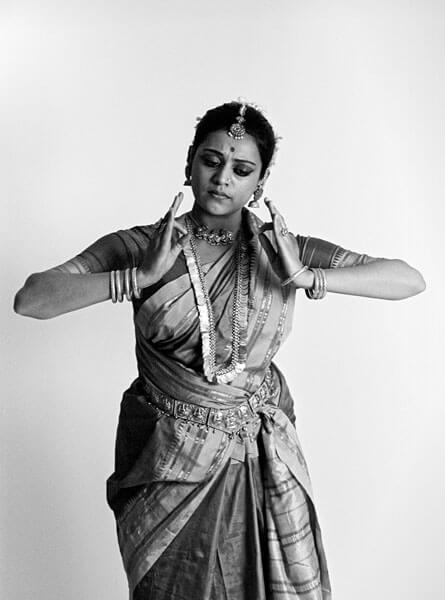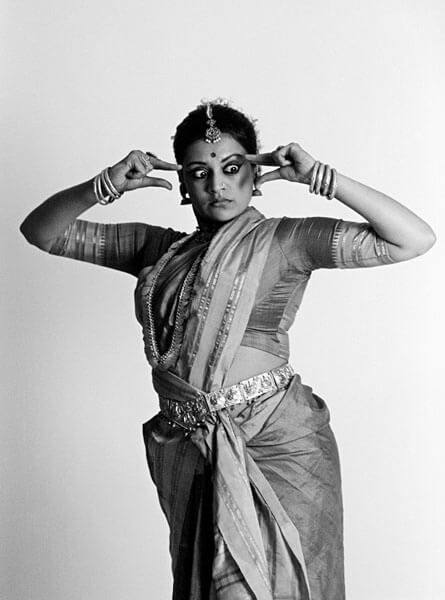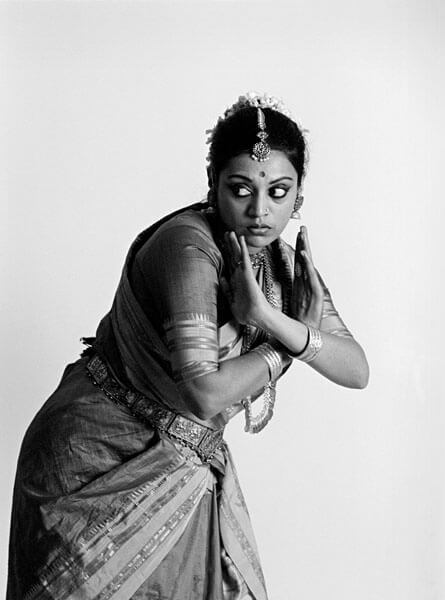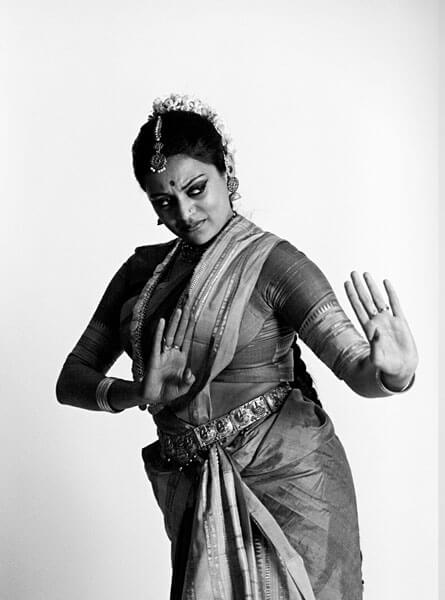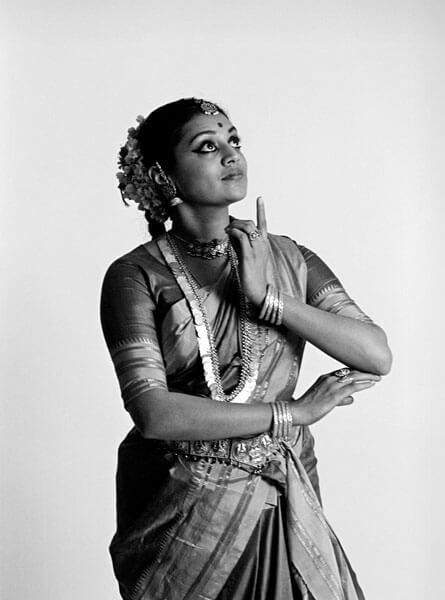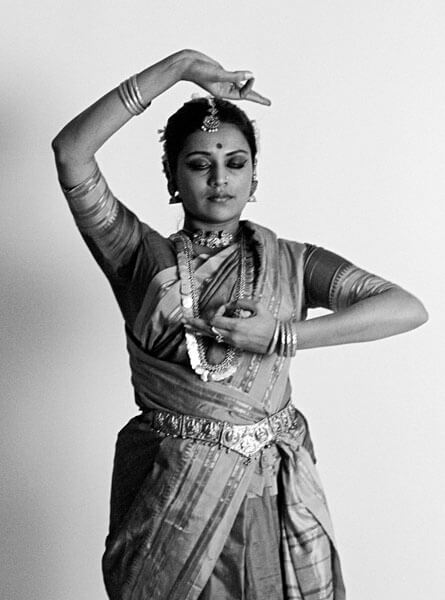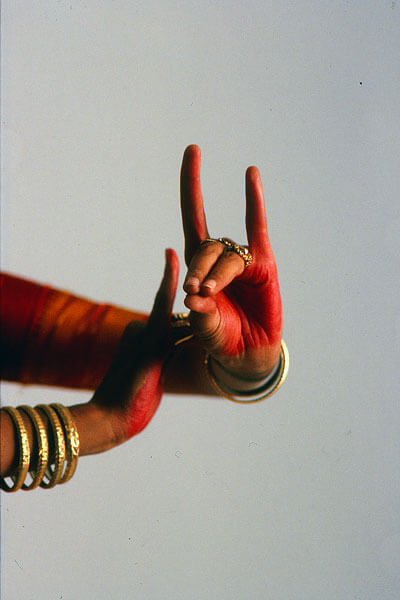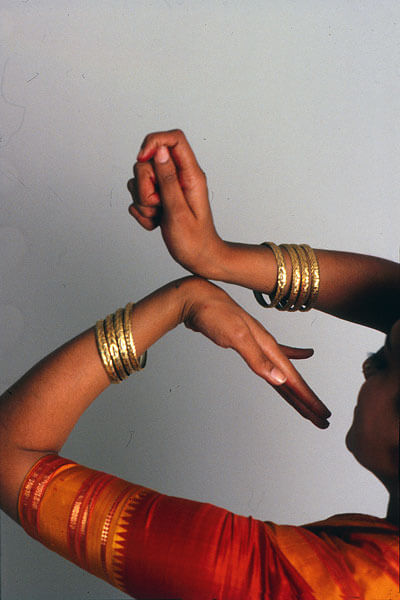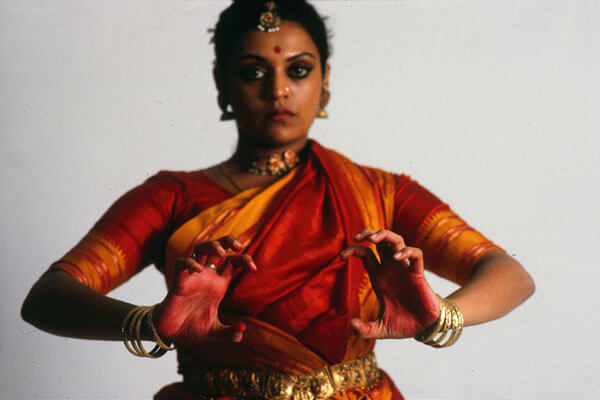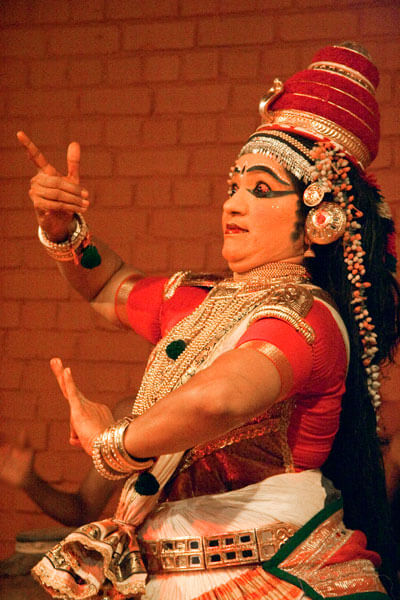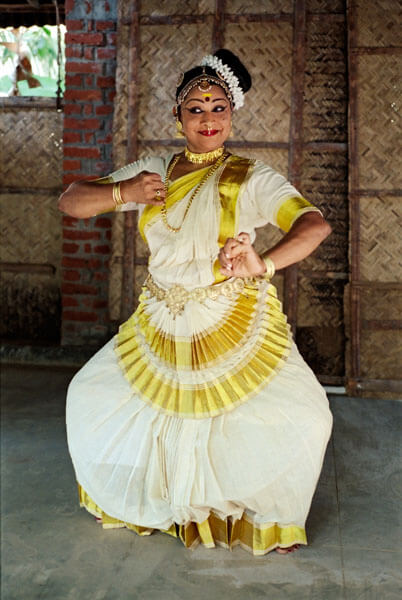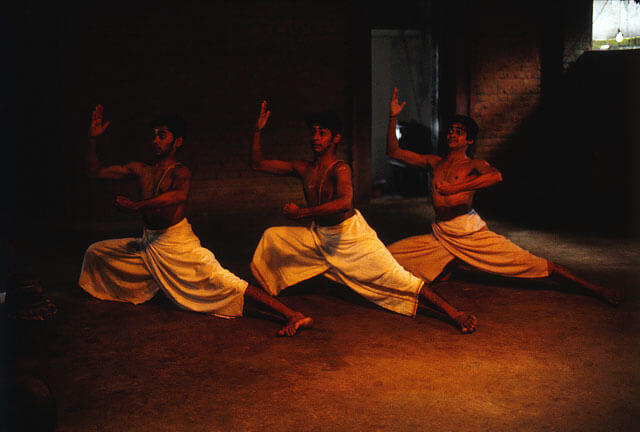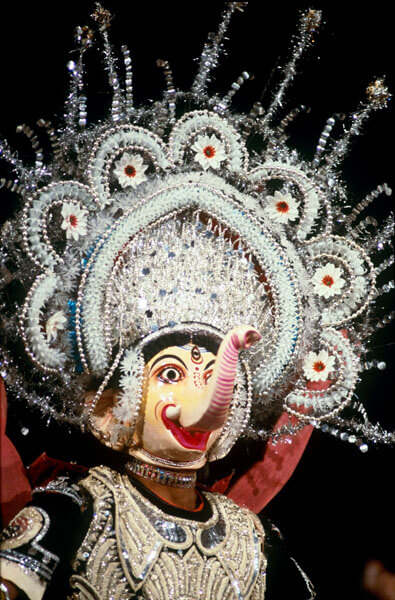Bharata and his Natyashastra
The myth of the origin of theatre in India, told at the very beginning of the Natyashastra, or the Drama Manual, shows the central role of theatre and dance in Indian culture. Natya, the art of theatre (including dance), was the work of God Brahma, the creator, who was asked to give mankind a fifth Veda, which, unlike the four earlier Vedas, could be understood by everyone, even those who did not know Sanskrit (i.e., the two lowest casts). Thus Brahma created the Natya Veda, with the assistance of other gods.
Natya was then taught by God Brahma to the mythic sage Bharata, who is said to have recorded this teaching in the Natyashastra. The origin of the book is thus shrouded in mythology, but the work itself is indeed living reality. The Natyashastra is probably the world’s largest and most comprehensive theatre and dance manual, and it still forms the foundation of the classical forms of theatre and dance in India.
The instructions of the Natyashastra became established through centuries of practical theatre work. The compilation of this treatise dates back most probably to the second century AD, although the tradition formulated in it was older. Most probably it preserves information and practices that for generations had already originally been conveyed orally.
Natyashastra’s 36 chapters give instructions on almost all aspects of theatre and dance: the theatre building, the stage, the theory of poetry, the use of the voice, make-up, costume, acting styles, dance techniques, and even theatre criticism.
The Theory of Rasa
The Natyashastra introduced the theory of bhava and rasa, so central to Indian aesthetics. It had a profound effect on most of the traditional art forms of India. Bhava means an emotional state or mood, portrayed by the dancer-actor.
- Srngara, the sentiment of love Sakari Viika
- Hasya, the sentiment of happiness Sakari Viika
- Karuna, the pathetic sentiment Sakari Viika
- Raudra, the furious sentiment Sakari Viika
- Vira, the heroic sentiment Sakari Viika
- Bhayanaka, the terrifying sentiment Sakari Viika
- Bibhatsa, the odious sentiment Sakari Viika
- Abhuta, the sentiment of marvel Sakari Viika
- Santa, the sentiment of tranquillity Sakari Viika
Rasa, “taste” or “essence”, refers to the sentiment that the bhava, manifested by the actor, should evoke in the audience. The rasas were originally eight in number, but the post-Natyashastra tradition added a ninth one.
- The Erotic (srngara),
- The Comic (hasya),
- The Pathetic (karuna),
- The Furious (raudra),
- The Heroic (vira),
- The Terrible (bhayanaka),
- The Odious (bibhatsa),
- The Marvellous (abhuta) and
- The Tranquil (santa).
According to this theory, one of these permanent sentiments should govern any good work of art.
According to Bharata, the actor-dancer should be able to elicit the rasa experience in the audience through the stahyi bhava or permanent emotion, which is supported by the determinants (vibhava) and stimulants (anubhava). These are further elaborated upon through different transitory states of mind.
If all goes well, the spectator then receives these various signals, which awake the particular sentiment in question in his or her mind. However, not everyone is able to experience it. In order to be able to recognise or receive the rasa, or the “essence”, the spectator should be a sensitive and cultivated person, a rasika.
The Textual Level
Bharata points out that the word or text is the basis of theatre. The Natyashastra thus gives much space to the construction of a play. Its chief protagonist is usually a hero, often a king or a prince, and the five stages of the play are seen from his point of view. They are (1) the beginning, (2) the effort, (3) the possibility of attainment, (4) the possibility of resolution still overshadowed by conflicts and/or obstacles and, finally, (5) the fruition.
The Natyashastra gives four different styles of natya or stylised acting: (1) the graceful, (2) the energetic, (3) the grand, and (4) the verbal. The last one is probably is the nearest equivalent to Western spoken theatre.
Body Language and its Sub-techniques
There are two main styles of conveying drama, the stylised or symbolic one, natya, and the realistic one, loka. The stylised way, natya, combines dance or dance-like movements with facial expression. Dance was an integral part of stylised acting, while later it also became an independent form of art, as described in several post-Natyashastra treatises.
The classical Indian dance technique described in the Natyashastra is one of the most detailed and complex in the world. It includes 108 karanas or basic dance units, four ways of standing, 32 movements of the feet and hips, nine neck movements, seven movements for eyebrows, 36 types of gaze, and symbolic hand gestures, 24 for one hand and 13 for both hands etc.
The dancer-actor’s whole body, from the soles of his or her feet to the eyelids and fingertips, are trained to be a versatile means of expression through years of work in order to be able the express the rasa.
Mudras, Symbolic Hand Gestures
The use of mudra (also hasta), the symbolic hand gestures, is especially characteristic of Indian dance and theatrical expression. The mudras most probably developed from the magic gestures of the ancient Veda rituals. In Indian theatre and dance, various combinations of mudras permit the dancer-actor to express himself or herself with distinct and nuanced language of gestures.
- A mudra or symbolic hand gesture denoting two deer Sakari Viika
- A parrot Sakari Viika
- Opening of a lotus flower Sakari Viika
- A man-lion Sakari Viika
The need for such a form of expression appears to have been based on the fact that the early drama texts were in often in Sanskrit, which was understood only by the two higher casts, while the gesture language could be, at least in principle, comprehended by all.
In South-East Asia, symbolic hand gestures are also an essential feature of dance, but they did not develop into a specific gesture language. For example, Javanese, classical dance involves only four gestures of the hands, which have different meanings in various contexts or no specific literary meaning at all.
Abstract and Expressive Dance
- Pure, abstract nrtta dance section from the bharatanatyam repertoire Sakari Viika
- Abhinaya mime acting in the nangiarkuttu style Jukka O. Miettinen
In the Natyashastra the dance is divided into two basic categories; they are nrtta or the abstract, “pure” dance, which does not convey any story or specific mood, and nritya or dance with rasa moods, often serving as a medium to convey a story. Nritya is also often called abhinaya and this term will also be used here.
The nrtta is constructed of the technique of rendering the rhythm (tala) through movements that do not have any specific meaning, and the skill of projecting frozen, sculptural poses within a given rhythmic cycle.
In the present dance traditions a dance number or a whole recital often combine nrtta dances and abhinaya numbers. Abhinaya technique in itself is a complicated “science” of body language, hand gestures, and facial expressions culminating in the eye movements. The term abhinaya indicates all that which “brings the thing to the audience”.
Lasya and Tandava, the Feminine and Masculine Style
- Mohiniattam belongs to the soft, “feminine” lasya styles Sakari Viika
- Training of the energetic, “masculine” tandava technique of kutiyattam Jukka O. Miettinen
The Natyashastra mentions two different dance styles. They are lasya and tandava. Tandava is related to the powerful creative and destructive cosmic dance of God Shiva, while lasya is said to have been created by Shiva’s spouse, Goddess Parvati.
Traditionally these terms are used to indicate the style of dance, i.e. lasya is a soft and graceful style, while tandava is strong, even aggressive, in style. Both styles can be performed by either male or female dancers. Lasya also indicates a performance style in which a solo performer enacts a text sung by a singer by means of gestures and mime.
Abhinaya, the Physical Storytelling
The facial muscles, eyes, eyebrows, etc., are trained and developed as consistently as the body, hands, and feet. Facial technique is central to the expression of the rasa mood, and it can even be developed to the level where the actor can express joy with one half of his face and sorrow with the other.
In fact, the culmination of the whole acting happens in the eyes of the performer. His or her gaze must follow the hand movements, while the facial expression then gives meaning to the gesture. Thus, when a dancer, with his or her hand movements, depicts, for example, the opening of a lotus flower, his or her eyes are able to give different emphases to the gesture.
For example, if the flower is especially beautiful, the facial expression and the eyes may express the sentiment of wonder. However, if there is a poisonous snake in it, the actor’s eyes and face may express horror. Thus the eye and facial movements in general, with their ability to convey a mood, are able to give almost endlessly different meanings to the symbolic hand gestures.
If it is compared with the traditional Western acting technique, the natya differs from it in one particular aspect. In the West the focus is on the action manifested by the actor while in classical Indian acting technique the focus is on the character’s reactions to that action.
The whole complicated process of conveying the rasa through the natya technique is crystallised in the famous dictum:
Where the hand goes, eyes follow.
Where the eye goes, there the mood follows.
Where the mind goes, there arises the sentiment.
The Construction of Rasa
The rasa theory has been discussed above only in simplified outlines. In fact, the process of creating the rasa sentiment is more complicated. An often used example is the creation of rasa of love on the stage.
When a character on stage is in love, the sentiment of love is the ruling and continuing emotional state or stahyibhava manifested by the actor. The context for this emotional state is provided by text describing the lovers, appropriate music, costumes, make-up system etc. The emotion of love is further manifested by facial expressions, such as amorous glances, smiles, flirting etc. These physical actions are called anubhavas.
The manifestation of love needs to be elaborated. Accessory feelings, such as hope, doubt, jealousy, longing etc. are intermingled with the basic emotion of love. These rising and falling supporting emotions are called vyabhicaribhavas and they are 37 in number. All these leading and accessory emotions, as well as voluntary and involuntary actions, aim to create the sentiment of love in the audience.
The Actor’s Tools
According to the Natyashastra the actor has four principal “toolboxes” to aid the acting process. They are
- aharya or costumes and make-up
- vacika or spoken or sung words,
- angika or the various aspects of the actual body language, and
- sattvika or the expression of inner emotions.
The natya acting technique described above relies thoroughly on the angika body language and the aharya expression of inner moods. This acting/dancing technique can be regarded as the margi style, meaning the classical tradition, still represented by the present classical styles, such as bharatanatyam, odissi, kutiyattan, kathakali etc, all discussed later.
The opposite to the margi style is the desi style, indicating “regional” or “lesser” styles, not so closely connected to the Natyashastra tradition. This classification into the “classical” and “folk” styles is not found in the Natyashastra but was created later when several dance manuals concentrated on regional styles.
The Natyashastra clearly indicates that there were already several styles of theatre as well as different acting techniques during the time of its compilation. This is also very true at the moment. The way in which the four “toolboxes” are used in each tradition varies greatly. For example, in some traditions the actor speaks or recites his lines, while in another style the actor only embodies the role character while a singer or a narrator takes care of the vacika or verbal aspect of the performance.
- Some theatrical styles, such as chhau, employ colourful masks Sakari Viika
- Many of the solo dance styles employ simple basic make-up Sakari Viika
- Several theatrical forms, kathakali among them, have various standard make-ups for different role types Sakari Viika
The same is also the case with the aharya or the outer aspect of the acting, i.e. costumes, make-up etc. In some tradition the actor wears standard make-up and a standard costume regardless of what role he or she is acting, while in some traditions there are clear role types with their characteristic costumes, make-up or masks.


